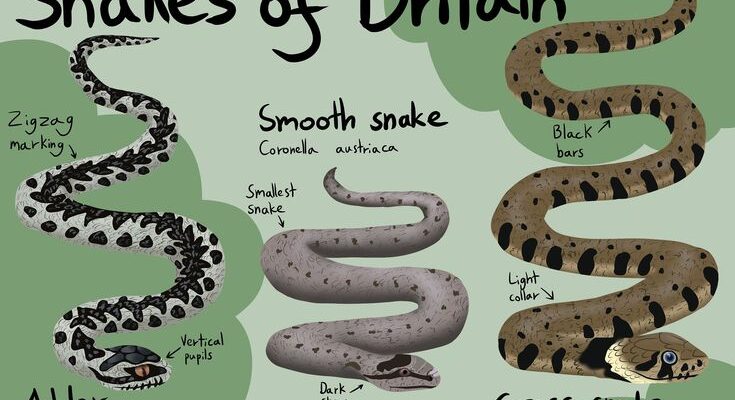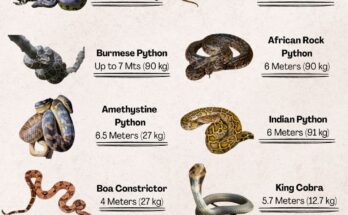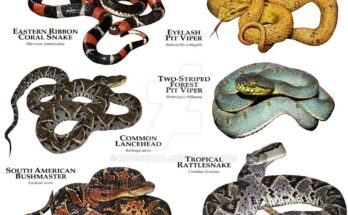Snakes of Britain: A Detailed Guide to the Native Species
Britain is home to a modest yet fascinating array of snake species, each with distinct features and habitats that contribute to the country’s natural heritage. This comprehensive guide explores the three native snakes of Britain—Adder, Smooth Snake, and Grass Snake—based on the vivid illustrations provided. Whether you’re a wildlife enthusiast, a hiker, or simply intrigued by these reptiles, this detailed overview will help you identify and appreciate these creatures in their natural environments.

1. Adder (Vipera berus)
The Adder is Britain’s only venomous snake, making it a species of particular interest. Recognizable by its striking zigzag marking that runs along its back, this snake features a pattern of dark, diamond-shaped blotches on a lighter background, typically gray, brown, or reddish. Its head is broad with a distinct V-shape between the eyes, and it possesses vertical pupils, a key identifier. Adults generally range from 60 to 80 cm in length, with males often displaying a more pronounced zigzag. Adders thrive in a variety of habitats, including heathlands, woodlands, and moorlands, where they bask on sunny days to regulate their body temperature. Though their bite is rarely fatal to humans, it requires medical attention, and these snakes are generally shy, preferring to retreat rather than confront. Their diet consists mainly of small mammals, birds, and lizards.
2. Smooth Snake (Coronella austriaca)
The Smooth Snake is the smallest and rarest of Britain’s native snakes, often overlooked due to its subtle appearance. Its body is slender and covered in smooth scales, with a uniform grayish-brown or olive coloration accented by a distinctive dark stripe running along each side of its head. This non-venomous species typically grows to 60-75 cm, though some may reach up to 90 cm. The Smooth Snake lacks the bold patterns of its counterparts, relying on its earthy tones for camouflage in heathlands and sandy heaths, particularly in southern England. It is a constrictor, feeding primarily on lizards, small mammals, and occasionally other snakes. Due to its elusive nature and protected status, sightings are rare, making it a prized find for herpetologists and nature lovers.
3. Grass Snake (Natrix helvetica)
The Grass Snake, Britain’s longest native snake, is a non-venomous species known for its elegant appearance and adaptability. It features a series of black bars along its back, set against a greenish-brown or gray background, with a noticeable light collar around its neck—a hallmark of the species. Adults can grow up to 120-150 cm, with females typically larger than males. This snake is an excellent swimmer, often found near ponds, rivers, and wetlands, where it hunts for amphibians like frogs and toads, as well as small fish. Its round pupils and lack of facial pits distinguish it from venomous snakes. When threatened, the Grass Snake may play dead or release a foul-smelling secretion to deter predators. Widespread across England and Wales, it is a common sight in gardens and countryside areas.
Exploring Britain’s Snake Diversity
These three species represent the entirety of Britain’s native snake population, each adapted to specific ecological niches. The Adder’s venomous nature contrasts with the harmless, yet resourceful, Smooth and Grass Snakes, showcasing the diversity within this small group. The image above provides a visual aid to help identify these snakes by their unique markings and physical traits. Adders favor drier, open landscapes, while Smooth Snakes are confined to specific heathland reserves, and Grass Snakes thrive near water sources. Observing them in the wild offers a glimpse into Britain’s natural balance, though caution is advised with Adders—maintain a safe distance and avoid handling any snake unless trained.
Conservation and Appreciation
All three species are protected under UK law due to habitat loss and persecution, emphasizing the need for conservation efforts. Whether you’re exploring the heathlands of Dorset for a Smooth Snake, the moors for an Adder, or a local pond for a Grass Snake, respect their space and contribute to their preservation. This guide, inspired by the detailed illustration, serves as an educational tool for enthusiasts and casual observers alike. For more information on snake habitats or safety guidelines, consult local wildlife organizations to enhance your appreciation of Britain’s serpentine residents.
Note: Always prioritize safety and refer to local wildlife resources when encountering snakes in the wild.



